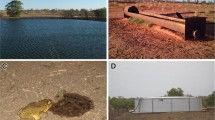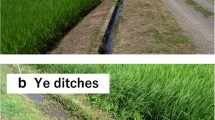Abstract
The spatial configuration of landscapes can be an important factor influencing the dispersal, distribution and abundance of invasive animals and consequently their impacts. In arid landscapes worldwide, humans have increased the availability of surface water by creating artificial water points (AWP) for livestock and wildlife viewing. The resource subsidy provided by AWP can influence the functioning of arid ecosystems by affecting the density, distribution and activity of water-dependent native and invasive animals and thus facilitate their trophic and competitive interactions. In this study, we used dung count indices to investigate the activity of an invasive herbivore, feral goats (Capra hircus), and native herbivores (kangaroos, Macropus spp.) in relation to surface water and habitat type in three conservation reserves located in arid Australia. Activity of feral goats showed a strong preference for rocky ranges habitat and decreased with distance from water. Kangaroo activity showed a strong preference for mulga woodlands, but was independent of distance from water. Our results suggest that artificial water points may exacerbate the impacts of feral goats by functioning as focal points for their activity. Restricting goats’ access to water by closure of water points or strategic fencing, such that the mean distance to water across the landscape is increased, may be an effective strategy to reduce goat grazing impacts in conservation reserves where natural sources of water are scarce but is unlikely to affect the grazing patterns of kangaroos. Our study suggests that there is scope to control populations of water-dependent invasive vertebrates in arid regions by restricting their access to artificial water points.







Similar content being viewed by others
References
Chamaille-Jammes S, Valeix M, Fritz H (2007) Managing heterogeneity in elephant distribution: interactions between elephant population density and surface-water availability. J Appl Ecol 44(3):625–633. doi:10.1111/j.1365-2664.2007.01300.x
Choquenot D, Forsyth DM (2013) Exploitation ecosystems and trophic cascades in non-equilibrium systems: pasture–red kangaroo–dingo interactions in arid Australia. Oikos 122:1292–1306
Dawson TJ, Taylor CR (1973) Energetic cost of locomotion in kangaroos. Nature 246:313–314
Dawson TJ, Denny MJS, Russell EM, Ellis B (1975) Water usage and diet preferences of free ranging kangaroos, sheep and feral goats in the Australian arid zone during summer. J Zool 177(1):1–23
Dawson TJ, McTavish KJ, Munn AJ, Holloway J (2006) Water use and the thermoregulatory behaviour of kangaroos in arid regions: insights into the colonization of arid rangelands in Australia by the Eastern Grey Kangaroo (Macropus giganteus). J Comp Physiol [B] 176:45–53
Di Tomaso JM (2000) Invasive weeds in rangelands: species, impacts, and management. Weed Sci 48(2):255–265
Dougill AJ, Thomas DSG, Heathwaite AL (1999) Environmental change in the Kalahari: integrated land degradation studies for nonequilibrium dryland environments. Ann Assoc Am Geogr 89:420–442
Edwards G, Clancy T, Lee J, Mcdonnell J (1997) An evaluation of feral goat control methods on Currawinya National Park, south-western Queensland. Rangel J 19(2):166–173. doi:10.1071/RJ9970166
ESRI (2008) ArcGIS desktop: release 9.3. Environmental Systems Research Institute, Redlands
Fensham RJ, Fairfax RJ (2008) Water-remoteness for grazing relief in Australian arid-lands. Biol Conserv 141(6):1447–1460. doi:10.1016/j.biocon.2008.03.016
Finch NA, Murray PJ, Dunn MT, Billingsley J (2006) Using machine vision classification to control access of animals to water. Aust J Exp Agric 46(7):837–839. doi:10.1071/EA05325
Florance D, Webb JK, Dempster T, Kearney MR, Worthing A, Letnic M (2011) Excluding access to invasion hubs can contain the spread of an invasive vertebrate. Proc R Soc B-Biol Sci 278(1720):2900–2908. doi:10.1098/rspb.2011.0032
Forsyth DM, Barker RJ, Morriss G, Scroggie MP (2007) Modeling the relationship between fecal pellet indices and deer density. J Wildl Manag 71(3):964–970
Forsyth DM, Parkes JP, Woolnough AP, Pickles G, Collins M, Gordon I (2009) Environmental and economic factors determine the number of feral goats commercially harvested in Western Australia. J Appl Ecol 46(1):101–109
Forsyth DM, Wright EF, Monitoring ungulates in steep non-forest habitat: a comparison of faecal pellet and helicopter counts. N Z J Zool. doi:10.1080/03014223.2014.936881
Freudenberger D, Barber J (1999) Movement patterns of feral goats in a semi-arid woodland in eastern Australia. Rangel J 21(1):71–81. doi:10.1071/rj9990071
Fukuda Y, McCallum HI, Grigg GC, Pople AR (2009) Fencing artificial waterpoints failed to influence density and distribution of red kangaroos (Macropus rufus). Wildl Res 36(6):457–465. doi:10.1071/wr08122
Gormley AM, Forsyth DM, Griffioen P, Lindeman M, Ramsey DS, Scroggie MP, Woodford L (2011) Using presence-only and presence-absence data to estimate the current and potential distributions of established invasive species. J Appl Ecol 48(1):25–34
Graz FP, Westbrooke ME, Florentine SK (2012) Modelling the effects of water-point closure and fencing removal: a GIS approach. J Environ Manage 104:186–194. doi:10.1016/j.jenvman.2012.03.014
Howery LD, Provenza FD, Banner RE, Scott CB (1998) Social and environmental factors influence cattle distribution on rangeland. Appl Anim Behav Sci 55:231–244
Hulme PE (2009) Trade, transport and trouble: managing invasive species pathways in an era of globalization. J Appl Ecol 46(1):10–18. doi:10.1111/j.1365-2664.2008.01600.x
James CD, Landsberg J, Morton SR (1999) Provision of watering points in the Australian arid zone: a review of effects on biota. J Arid Environ 41(1):87–121
King D (1992) Home ranges of feral goats in a pastoral area in Western Australia. Wildl Res 19(6):643–649. doi:10.1071/wr9920643
Landsberg J, Stol J (1996) Spatial distribution of sheep, feral goats and kangaroos in woody rangeland paddocks. Rangel J 18(2):270–297
Landsberg J, Stol J, Muller W (1994) Telling the sheep (dung) from the goats. Rangel J 16(1):122–134
Landsberg J, James CD, Morton SR, Muller WJ, Stol J (2003) Abundance and composition of plant species along grazing gradients in Australian rangelands. J Appl Ecol 40:1008–1024
Lange RT (1969) The piosphere: sheep track and dung patterns. J Range Manag 22:396–400
Letnic M (2000) Dispossession, degradation and extinction: environmental history in arid Australia. Biodivers Conserv 9(3):295–308
Letnic M, Crowther MS (2013) Patterns in the abundance of kangaroo populations in arid Australia are consistent with the exploitation ecosystems hypothesis. Oikos 122:761–769
Letnic M, Ritchie EG, Dickman CR (2012) Top predators as biodiversity regulators: the dingo Canis lupus dingo as a case study. Biol Rev 87(2):390–413. doi:10.1111/j.1469-185X.2011.00203.x
Letnic M, Webb JK, Jessop TS, Florance D, Dempster T (2014) Artificial water points facilitate the spread of an invasive vertebrate in arid Australia. J Appl Ecol 51(3):795–803
Ludwig J, Tongway D, Hodgkinson K, Freudenberger D, Noble J (1997) Landscape ecology, function and management: principles from Australia’s rangelands. CSIRO Publishing, Collingwood
Melville GJ, Tracey JP, Fleming PJS, Lukins BS (2008) Aerial surveys of multiple species: critical assumptions and sources of bias in distance and mark-recapture estimators. Wildl Res 35(4):310–348. doi:10.1071/WR07080
Moleele NM, Perkins JS (1988) Encroaching woody plant species and boreholes: is cattle density the main driving factor in the Olifants Drift communal grazing lands, south-eastern Botswana? J Arid Environ 40:245–253
Montague-Drake R, Croft DB (2004) Do kangaroos exhibit water-focused grazing patterns in arid New South Wales? A case study in Stuart National Park. Aust Mammal 26:87–100
Moody ME, Mack RN (1988) Controlling the spread of plant invasions: the importance of nascent foci. J Appl Ecol 25(3):1009–1021. doi:10.2307/2403762
Munn AJ, Dawson TJ, McLeod SR, Croft DB, Thompson MB, Dickman CR (2009) Field metabolic rate and water turnover of red kangaroos and sheep in an arid rangeland: an empirically derived dry-sheep-equivalent for kangaroos. Aust J Zool 57(1):23–28
Munn AJ, Cooper CE, Russell B, Dawson TJ, McLeod SR, Maloney SK (2012) Energy and water use by invasive goats (Capra hircus) in an Australian rangeland, and a caution against using broad-scale allometry to predict species-specific requirements. Comp Biochem Physiol Part A Mol Integr Physiol 161(2):216–229
Newsome A (1965) The distribution of red kangaroos, Megaleia rufa (Desmarest), about sources of persistent food and water in central Australia. Aust J Zool 13(2):289–300. doi:10.1071/ZO9650289
Norbury G (1993) The use of 1080 to control feral goats in Western Australia. The proposed use of 1080 to control feral goats in Western Australia. Public Environmental Review EPA Assessment No. 752. Agriculture Protection Board of Western Australia, Perth, Australia
Olson LJ (2006) The economics of terrestrial invasive species: a review of the literature. Agric Resour Econ Rev 35(1):178
Packer C, Brink H, Kissui BM, Maliti H, Kushnir H, Caro T (2011) Effects of trophy hunting on lion and leopard populations in Tanzania. Conserv Biol 25(1):142–153. doi:10.1111/j.1523-1739.2010.01576.x
Perkins JS, Thomas DSG (1993) Spreading deserts or spatially confined environmental impacts? Land degradation and cattle ranching in the Kalahari Desert of Botswana. Land Degrad Rehabil 4:179–194
Pople AR, Grigg GC, Cairns SC, Alexander P, Beard LA, Henzell RP (1996) Trends in numbers and changes in the distribution of feral goats (Capra hircus) in the South Australian pastoral zone. Wildl Res 23(6):687–696. doi:10.1071/wr9960687
Pople AR, Grigg GC, Cairns SC, Beard LA, Alexander P (2000) Trends in the numbers of red kangaroos and emus on either side of the South Australian dingo fence: evidence for predator regulation? Wildl Res 27:269–276
Pridell D (1987) The mobility and habitat untilisation of kangaroos. In: Caughley G, Shepherd N, Short J (eds) Kangaroos: their ecology and management in the sheep rangelands of Australia. Cambridge University Press, Cambridge, pp 100–118
R Development CoreTeam (2009) R: a language and environment for statistical computing. R Foundation for Statistical Computing. http://www.R-project.org
Redfern JV, Grant R, Biggs H, Getz WM (2003) Surface-water constraints on herbivore foraging in the Kruger National Park, South Africa. Ecology 84(8):2092–2107. doi:10.1890/01-0625
Redfern JV, Grant CC, Gaylard A, Getz WM (2005) Surface water availability and the management of herbivore distributions in an African savanna ecosystem. J Arid Environ 63(2):406–424. doi:10.1016/j.jaridenv.2005.03.016
Russell BG, Letnic M, Fleming PJS (2011) Managing feral goat impacts by manipulating their access to water in the rangelands. Rangel J 33(2):143–152. doi:10.1071/rj10070
Smit IPJ, Grant CC, Devereux BJ (2007) Do artificial waterholes influence the way herbivores use the landscape? Herbivore distribution patterns around rivers and artificial surface water sources in a large African savanna park. Biol Conserv 136(1):85–99. doi:10.1016/j.biocon.2006.11.009
Underhill S, Grigg GC, Pople AR, Yates DJ (2007) A physiological assessment of the use of water point closures to control kangaroo numbers. Wildl Res 34(4):280–287. doi:10.1071/wr06041
Walker P (1991) Land systems of western New South Wales. New South Wales Conservation Service, Sydney
Webb JK, Letnic M, Jessop TS, Dempster T (2014) Behavioural flexibility allows an invasive vertebrate to survive in a semi arid environment. Biol Lett 281:20131014
Webster K, Dawson T (2004) Is the energetics of mammalian hopping locomotion advantageous in arid environments? Aust Mammal 26(2):153–160. doi:10.1071/AM04153
Westbrooke M, Leversha J, Gibson M, O’Keefe M, Milne R, Gowans S, Harding C, Callister K (2003) The vegetation of Peery Lake area, Paroo-Darling National Park, western New South Wales. Cunninghamia 8(1):111–128
With KA (2002) The landscape ecology of invasive spread. Conserv Biol 16(5):1192–1203. doi:10.1046/j.1523-1739.2002.01064.x
Wood SN (2004) Stable and efficient multiple smoothing parameter estimation for generalized additive models. J Am Stat Assoc 99:673–686
Zuur A, Ieno EN, Walker NJ, Saveliev AA, Smith GM (2009) Mixed effects models and extensions in ecology with R. Springer, New York
Acknowledgments
This research was funded by a grant from the Natural Heritage Trust, National Feral Animal Control Program to ML and PF. We thank Kerry Holmes, Jim Balnaves, Brett Norman, Shirley Meyer, Bill Elliott, Joanne Pedlar, Glen Wheatly and Brian Lukins for their assistance with the fieldwork. Chris Gordon and Freya Gordon assisted with data entry.
Author information
Authors and Affiliations
Corresponding author
Additional information
Communicated by Iain James Gordon.
Rights and permissions
About this article
Cite this article
Letnic, M., Laffan, S.W., Greenville, A.C. et al. Artificial watering points are focal points for activity by an invasive herbivore but not native herbivores in conservation reserves in arid Australia. Biodivers Conserv 24, 1–16 (2015). https://doi.org/10.1007/s10531-014-0770-y
Received:
Revised:
Accepted:
Published:
Issue Date:
DOI: https://doi.org/10.1007/s10531-014-0770-y




